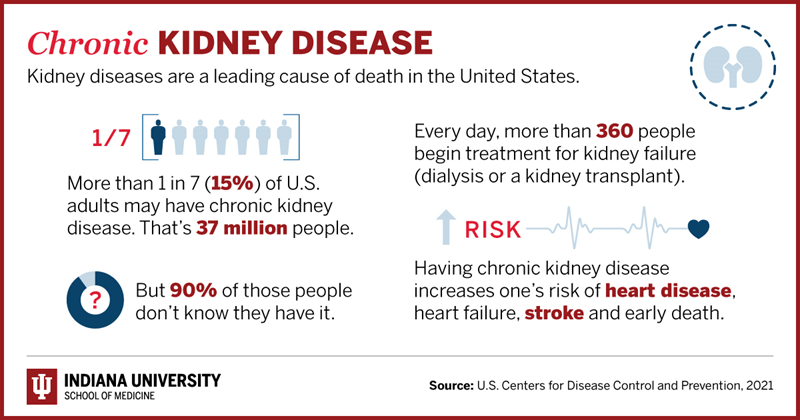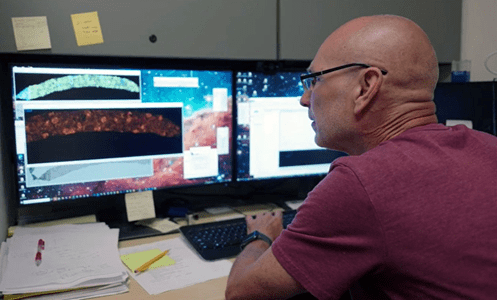IU School of Medicine scientists publish findings as part of NIH-funded research efforts to improve understanding of both chronic kidney disease and the cellular makeup of the human body
INDIANAPOLIS–Indiana University School of Medicine researchers have helped shed important light on the cellular makeup of the human kidney in both healthy and diseased states—findings that could help scientists identify new targets for early detection of and better treatments for kidney disease. They also found a correlation between kidney papillary injury, two molecules in the urine and the presence of kidney stone disease. Their work was recently published in Nature and Nature Communications.
The studies are part of two collaborative research efforts funded by the National Institutes of Health: the Human BioMolecular Atlas Program (HuBMAP) and the Kidney Precision Medicine Project (KPMP). As leading experts in both imaging and nephrology, IU School of Medicine researchers are key investigators on these efforts, which include scientists from around the United States and Europe.
"It’s a great privilege to play an important role in both of these studies,” said Tarek M. Ashkar (El-Achkar), MD, a corresponding author and co-principal investigator on the research papers and the Terence P. Kahn Professor of Nephrology at IU School of Medicine. “We’ve essentially created an incredibly detailed view of adult human kidney cells, using our advanced molecular imaging capabilities to provide a never-before-seen, complex spatial analysis of the kidneys at the cellular and molecular level.”
Media kit: Access video b-roll of the research team and a video interview with Ashkar
According to the U.S. Centers for Disease Control and Prevention, more than 1 in 7 adults in the U.S.—about 37 million people—may have chronic kidney disease, and every day, over 360 people begin treatment for kidney failure. But despite the large burden, kidney disease has been largely underfunded and understudied.
“A lot more needs to be done on early detection and prevention of kidney disease,” said Curtis Warfield, an Indianapolis resident and patient advocate on the IU School of Medicine study team. Warfield was diagnosed with stage 3 kidney disease in 2012, and his kidneys failed in 2014.
The only treatment for kidney failure is either dialysis, which helps your body filter out extra fluid and waste products from your blood, or a kidney transplant—both of which can have huge impacts on a person’s quality of life. At one point during Warfield’s treatment, he was on dialysis and taking 17 medications daily to manage his symptoms. That’s why early detection is so important, he said.

“These studies are exciting because kidney research has plateaued for a long time,” said Warfield, who eventually found a donor and got a kidney transplant in 2016. “Early detection is one thing patients are fighting for, and this will help.”
Ricardo Melo Ferreira, PhD, MS, an assistant research professor of medicine at IU School of Medicine and co-first author on the Nature papers, said the study findings, which will be shared out via HuBMAP, will help improve the scientific community’s understanding of kidney disease because they help paint a more detailed picture of kidney cells, which can be used to identify specific patterns and pathways to disease progression.
“It’s basically a map and a census that tells you what populations you’re looking at and where they are,” Melo Ferreira said.
Ashkar said one of the best and most unique parts of working on these research projects has been the involvement of patient advocates like Warfield.
“We’re really keeping patients at the center of this study,” Ashkar said. “Talking to patients really brings it home and keeps you energized, keeps you focused. You know that what you’re doing is relevant and impactful to people.”
The researchers said one of the main goals of these research efforts is to disseminate knowledge, so they hope other scientists will use these findings as a guide and apply the data to their own kidney disease research.
Other IU School of Medicine authors on the studies include Daria Barwinska, PhD; Michael J. Ferkowicz, PhD, MS; William Bowen, PhD; Angela Sabo, PhD; Pierre C. Dagher, MD; and Michael T. Eadon, MD.
About Indiana University School of Medicine
IU School of Medicine is the largest medical school in the U.S. and is annually ranked among the top medical schools in the nation by U.S. News & World Report. The school offers high-quality medical education, access to leading medical research and rich campus life in nine Indiana cities, including rural and urban locations consistently recognized for livability.




